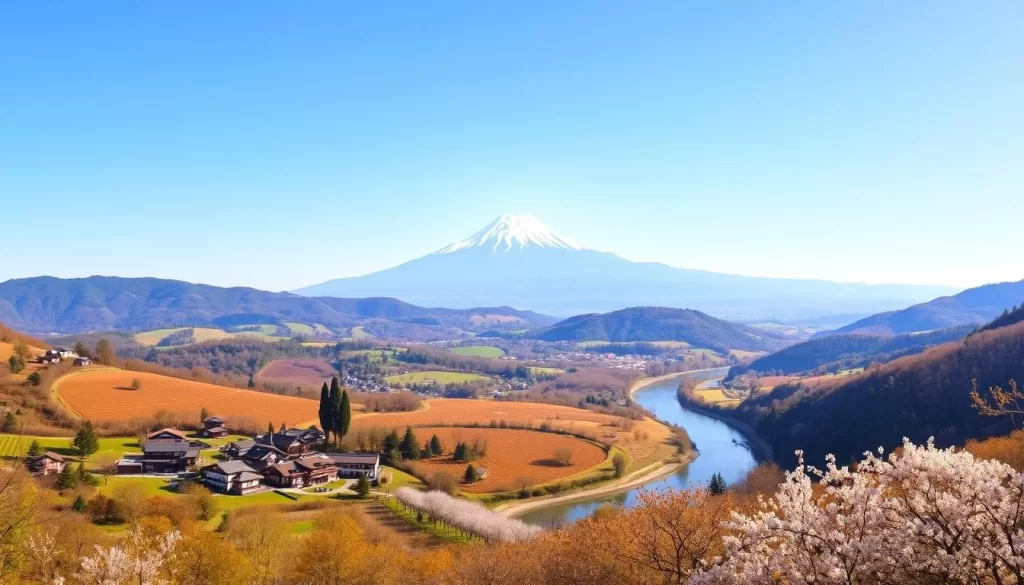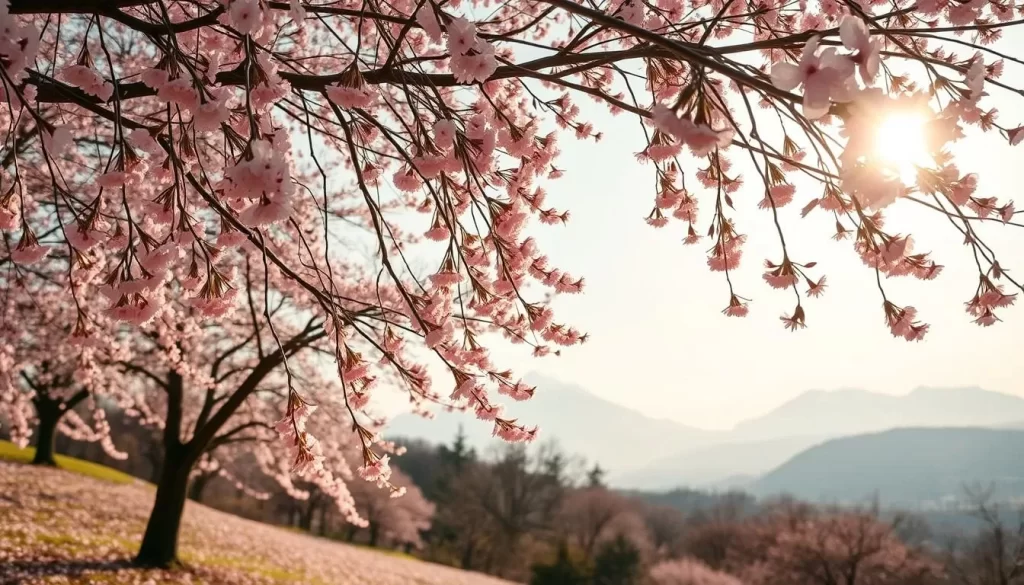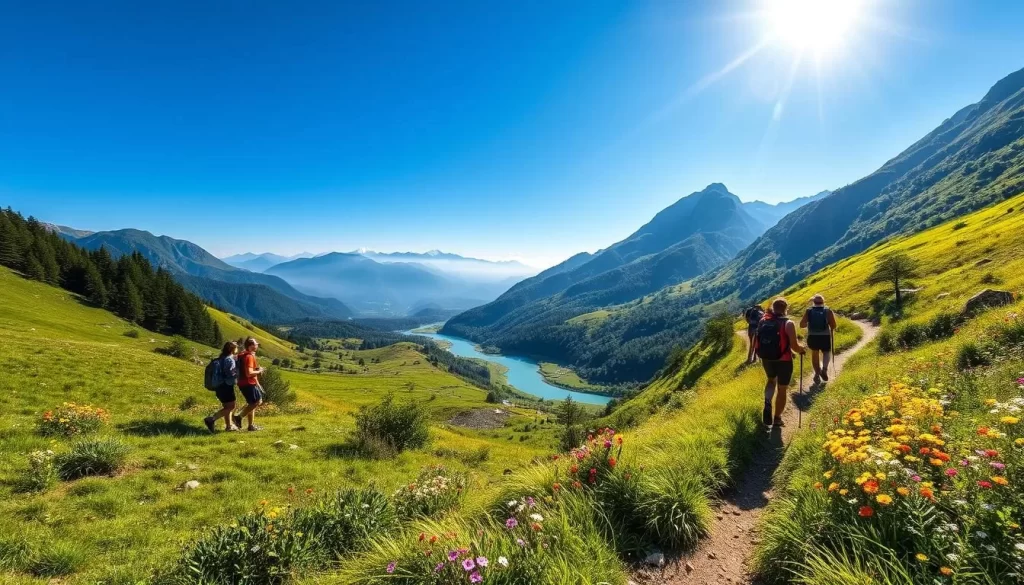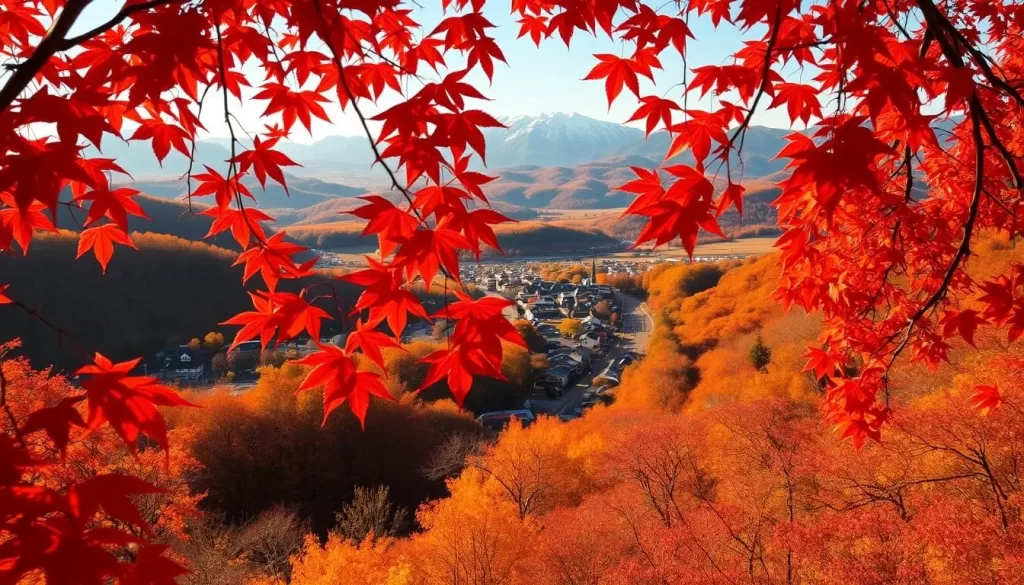✓ Accommodations ✓ Flights ✓ Rental Cars
Are you ready to experience the natural beauty of Yamanashi Prefecture? With its stunning landscapes, including the iconic Mount Fuji, beautiful lakes, and renowned vineyards, this region offers a unique Japanese experience. To make the most of your trip, understanding the local weather patterns is crucial.
The time you choose to visit can significantly impact your experience. Each season brings distinct attractions and activities, from cherry blossoms in spring to snow-capped mountains in winter.
This comprehensive guide will help you navigate Yamanashi’s seasonal weather patterns to plan the perfect trip. By understanding the local climate characteristics and peak tourist seasons, you can time your visit for maximum cultural immersion or peaceful exploration.
Understanding Yamanashi Prefecture’s Climate
Yamanashi Prefecture’s unique geography plays a significant role in shaping its climate. Located in central Japan, the prefecture is surrounded by mountains, including the iconic Mount Fuji, which significantly influences local weather patterns.
Geographic Location and Weather Patterns
Yamanashi Prefecture experiences four distinct seasons, each offering unique conditions for travelers. The mountainous terrain causes temperature variations within the prefecture, with higher elevations being cooler than valley areas. The prefecture’s position in a basin surrounded by mountains creates unique microclimates that can differ from general Japanese weather patterns.

How Mount Fuji Influences Local Climate
Mount Fuji creates a rain shadow effect, making Yamanashi’s climate drier than coastal areas of Japan, with less rainfall and more sunny days throughout the year. Understanding these local climate characteristics will help you pack appropriately and plan activities that align with the weather conditions during your visit. The best time to visit Yamanashi depends on what you want to experience, as each season offers different attractions and weather.
Spring in Yamanashi: Cherry Blossoms and Mild Weather
As the winter chill dissipates, Yamanashi Prefecture transforms into a vibrant landscape, making spring an ideal time to visit. The season brings with it mild weather and the iconic cherry blossoms, creating a perfect setting for outdoor activities and sightseeing.
March to May Weather Overview
Spring in Yamanashi, spanning from March to May, is characterized by mild temperatures ranging from 50°F to 73°F (10°C to 23°C). This period is considered the best time to visit Yamanashi Prefecture, as the weather is pleasant and conducive to exploring the outdoors. While early spring can still be cool, especially in higher elevations, the overall stability of the weather with only occasional light showers makes it ideal for hiking, sightseeing, and photography.
Cherry Blossom Season Highlights
The cherry blossom season is a major highlight of spring in Yamanashi. Typically beginning in late March and peaking in early April, the blossoms offer spectacular views, particularly around Lake Kawaguchiko with Mount Fuji as a stunning backdrop. The cherry blossom season is not just about the beauty; it’s also a time visit many look forward to, as it signifies the arrival of warmer days and outdoor festivities.

Spring Festivals and Activities
Spring festivals in Yamanashi celebrate the spring season with special events, illuminations, and traditional performances, showcasing the local culture. Beyond the cherry blossoms, other beautiful flowers like plum blossoms and wisteria bloom, creating colorful landscapes throughout the region. The comfortable spring temperatures also make it perfect for visiting Yamanashi’s wineries, which begin their new growing season during this time.
Some of the key experiences during spring include:
- Mild weather ideal for outdoor exploration
- Spectacular cherry blossom views around Lake Kawaguchiko
- Spring festivals celebrating local culture
- Visiting wineries during their new growing season
- Enjoying other spring flowers like plum blossoms and wisteria
Overall, spring is a wonderful season to experience Yamanashi Prefecture, with its pleasant weather, beautiful landscapes, and cultural events making it an attractive time visit for travelers.
Summer Adventures: Navigating the Heat and Rainy Season
Yamanashi Prefecture in the summer offers a blend of adventure and relaxation, as the region’s natural beauty shines through the hot and humid conditions. While the weather can be challenging, the prefecture’s diverse landscapes and activities make it an attractive destination for those willing to navigate the hot humid weather.
June to August Temperature and Humidity Patterns
Summer in Yamanashi, spanning from June to August, is characterized by high temperatures often reaching 88°F (31°C), accompanied by significant humidity. The prefecture’s elevation provides some relief compared to lower-lying areas like Tokyo, but it’s still a hot humid period. Temperatures vary by elevation, with mountainous regions around Mount Fuji being cooler than the valleys.
Rainy Season Considerations
The rainy season, or tsuyu, typically affects Yamanashi from mid-June to mid-July, bringing increased precipitation. Although it doesn’t rain every day, the weather tends to be overcast. This period also results in lush green landscapes and fewer crowds at popular attractions, making it a good time for travel if you’re prepared for the rain.
Summer Hiking and Outdoor Activities
Despite the rainy season, Yamanashi enjoys many sunny days in the summer, allowing for flexible planning of activities. The summer months are ideal for hiking the trails of Mount Fuji (officially open from early July to mid-September), swimming in the five lakes, and enjoying summer festivals. The longer daylight hours provide more time for exploration and outdoor adventures throughout the prefecture.

August brings the Obon holiday period, which can mean more crowded attractions but also special cultural events. Overall, summer is a vibrant time in Yamanashi, with temperatures and activities that cater to a variety of interests and preferences.
Autumn’s Colorful Splendor: Perfect Weather for Exploration
As the summer heat dissipates, Yamanashi Prefecture transforms into a vibrant autumn paradise, offering perfect weather for exploration. The autumn season, spanning from September to November, brings a unique charm to the region, making it an ideal time to visit.
September to November Weather Conditions
During the autumn months, Yamanashi experiences comfortable temperatures, ranging from 50°F to 75°F (10°C to 24°C), accompanied by lower humidity. This creates ideal conditions for outdoor activities and exploration. The clear skies and stable weather conditions offer breathtaking views of Mount Fuji, making it a photographer’s paradise.
Fall Foliage Viewing Spots
The fall foliage season in Yamanashi typically begins in mid-October at higher elevations and continues through November. Popular spots for viewing autumn colors include the Fuji Five Lakes region, Koyo Tunnel near Lake Kawaguchiko, and the forests around Shosenkyo Gorge. These areas transform into a kaleidoscope of red, orange, and golden colors, creating a spectacular display of nature’s beauty.
| Location | Best Time to Visit | Notable Features |
|---|---|---|
| Fuji Five Lakes region | Mid-October to November | Stunning views of Mount Fuji amidst autumn foliage |
| Koyo Tunnel near Lake Kawaguchiko | Late October to early November | A picturesque tunnel lined with vibrant autumn colors |
| Shosenkyo Gorge | Mid-October to November | A scenic gorge with stunning autumn foliage and traditional ryokans |
Harvest Season and Wine Tourism
The autumn season in Yamanashi coincides with the grape and wine harvest, making it an excellent time for wine tourism. Visitors can explore the prefecture’s renowned vineyards and wineries, such as Maruzen Winery and Chateau Mercian, and experience the wine-making process. The comfortable autumn weather also makes it ideal for hiking, cycling, and exploring the region’s numerous outdoor attractions without the summer crowds or winter chill.

Autumn festivals in Yamanashi celebrate the harvest season with food, music, and traditional events that showcase local culture and agricultural products. You can immerse yourself in the local culture and enjoy the festive atmosphere, making your visit to Yamanashi a memorable experience.
Winter Wonders: Snow, Hot Springs, and Clear Skies
The winter season brings a unique charm to Yamanashi, with its cold temperatures, snow, and breathtaking views of Mount Fuji. As you plan your trip, understanding the nuances of Yamanashi’s winter is crucial for making the most of your visit.
December to February Temperature Ranges
During the winter months, Yamanashi experiences temperatures ranging from 30°F to 50°F (-1°C to 10°C). At higher elevations, the temperatures are significantly colder, and snow is a common occurrence. This cold weather sets the stage for a variety of winter activities and experiences.
Winter Activities and Mount Fuji Views
Winter in Yamanashi is not just about the cold; it’s a season that offers a plethora of activities. You can enjoy skiing and snowboarding at resorts like Fujiten Snow Resort, or take part in winter hiking on lower elevation trails. The clear winter skies also provide perfect conditions for viewing and photographing Mount Fuji, making it a paradise for photographers.
Hot Spring Experiences in Cold Weather
One of the highlights of visiting Yamanashi in winter is the opportunity to relax in its hot springs (onsen). Locations such as Isawa Onsen and Yamanakako Onsen offer thermal baths with stunning mountain views, providing a perfect way to unwind and rejuvenate during the cold winter days.
With fewer tourists during the winter season, you can enjoy a more peaceful atmosphere at major attractions and have better opportunities for unobstructed photography. The contrast of snow-capped Mount Fuji against the clear blue winter skies creates some of the most iconic and photogenic scenes in Japan, making Yamanashi a must-visit destination in the winter.
Yamanashi Prefecture, Japan: Best Months for a Weather-Savvy Trip
When planning your trip to Yamanashi Prefecture, Japan, timing is everything to ensure a weather-savvy visit. The prefecture’s diverse climate means that certain times of the year are better suited to different activities and preferences.
April-May: Ideal for Cherry Blossoms and Mild Exploration
April to May is considered the ideal time to visit Yamanashi for cherry blossom viewing combined with comfortable weather conditions. The temperatures are perfect for outdoor exploration without the humidity of summer. The cherry blossom season typically peaks in early April, slightly later than Tokyo, providing a perfect opportunity to extend your cherry blossom viewing experience.
October-November: Perfect for Fall Colors and Clear Views
October to November offers the perfect combination of comfortable temperatures, low rainfall, and spectacular fall colors, making it arguably the best time to visit Yamanashi for weather-conscious travelers. The scenery is vibrant, with bright red leaves adding contrast to the landscape.
January-February: Best for Snow Activities and Mount Fuji Photography
January to February provides the best opportunities for clear, unobstructed views of Mount Fuji due to the dry winter air, making these months ideal for photographers seeking that perfect shot. The winter season also offers serene snow scenes and hot spring enjoyment, enhancing your travel experience.
In summary, the best time to visit Yamanashi depends on your preferences: April-May for cherry blossoms and mild weather, October-November for fall colors and clear views, or January-February for snow activities and Mount Fuji photography. Checking forecasts and being flexible with your travel dates within these recommended months can help ensure the best experience.
- April to May: Enjoy cherry blossoms and comfortable temperatures.
- October to November: Experience vibrant fall colors and clear skies.
- January to February: Take advantage of snow activities and clear views of Mount Fuji.
Planning Around Japanese Holidays and Peak Tourist Seasons
To make the most of your visit to Yamanashi, you should be aware of Japan’s peak travel seasons. Major holidays significantly impact tourist traffic, accommodation prices, and the overall travel experience.
Golden Week and Obon Festival Considerations
Golden Week, which takes place from late April to early May, is one of Japan’s busiest travel periods. During this time, consecutive holidays cause accommodation prices to rise, and popular attractions in Yamanashi become extremely crowded. Similarly, the Obon Festival in mid-August is another peak travel season when many Japanese return to their hometowns, leading to crowded transportation systems and busy tourist destinations. If you plan to visit during these times, it’s essential to book your accommodations and transportation well in advance.
| Holiday | Date | Impact on Travel |
|---|---|---|
| Golden Week | Late April to Early May | High demand, crowded attractions, higher accommodation prices |
| Obon Festival | Mid-August | Crowded transportation, busy tourist destinations |
Off-Peak Travel Benefits
Traveling during off-peak seasons offers several benefits, including lower accommodation rates, less crowded attractions, and a more relaxed pace when visiting Yamanashi’s natural and cultural sites. Weekdays generally offer a less crowded experience than weekends, making mid-week visits ideal for popular spots like the Fuji Five Lakes region and Shosenkyo Gorge. Consider planning your trip during these times to enhance your travel experience.
By understanding and planning around Japan’s major holidays and peak tourist seasons, you can have a more enjoyable and stress-free trip to Yamanashi Prefecture.
Conclusion: Making the Most of Your Yamanashi Visit
To truly appreciate the natural beauty and cultural richness of Yamanashi, timing your visit according to the seasonal weather patterns is crucial. When planning your trip to Yamanashi Prefecture, considering the climate will significantly enhance your overall experience and help you make the most of this beautiful region of Japan.
Spring and autumn offer the most balanced weather conditions for visiting Japan, particularly Yamanashi, with comfortable temperatures and spectacular natural displays. Regardless of when you visit Japan, Yamanashi offers unique experiences in each season.
Practical tips for your trip include packing layers for Yamanashi’s variable mountain weather, checking attraction opening times, and considering a rail pass. Allowing flexibility in your itinerary is also valuable, enabling you to adjust plans based on actual conditions during your time in Yamanashi.
By timing your visit strategically, you’ll be rewarded with better photos, more comfortable exploration, and a deeper appreciation of Yamanashi’s natural and cultural treasures. This thoughtful approach ensures your trip is memorable for all the right reasons.
The above is subject to change.
Check back often to TRAVEL.COM for the latest travel tips and deals.






